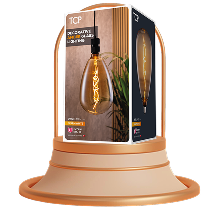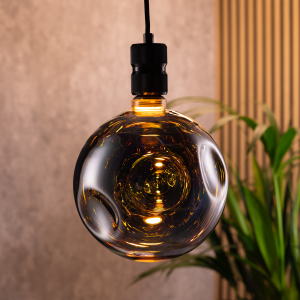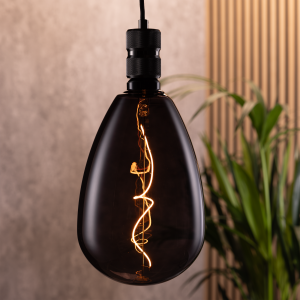LED light bulbs have transformed the way we light our homes, offering long-lasting performance, low energy consumption, and a huge range of designs to suit every space. Whether you’re looking to brighten a living room, add ambience to a dining area, or illuminate a workspace, there’s an LED bulb to match your needs. This guide breaks down the most common LED bulb types, fittings, and features so you can make the right choice for both style and practicality.
Common shapes of LED light bulbs
Each type of lightbulb shape is tailored for specific lighting needs — whether it’s creating a decorative feature, casting a soft ambient glow, or directing focused light onto a work surface. Understanding the shape helps you choose the best LED for both function and style in different rooms of the home.
- GLS (General Lamp Shape / A-shape / A60/A19) – This is the most common and recognisable bulb shape, closely resembling the traditional incandescent bulb. GLS bulbs are ideal for general-purpose lighting in ceiling fixtures, table lamps, and floor lamps. They come in a wide range of lumen outputs and colour temperatures, making them suitable for almost any room in the home.
- Candle (B35/B22/E14) – With their slim, tapered profile, candle bulbs are designed for open decorative fittings like chandeliers, wall sconces, or vintage-style holders. Their elegant form complements more traditional interiors, and many models are dimmable — perfect for dining rooms or mood lighting in lounges.
- Globe (G95/G125) – Globe bulbs have a large, round design that makes them a striking feature when left exposed. They’re often used in pendant lights above kitchen islands, mirrors in bathrooms, or statement lighting in living spaces. Their diffused light output creates soft ambient lighting, and they’re available in both clear and frosted finishes.
- Golf ball (G45) – Smaller and rounder than a GLS bulb, golf ball LEDs are perfect for tight spaces and smaller fittings, such as bedside lamps, bathroom vanities, or small table lamps. Despite their size, they offer excellent brightness and are commonly used where discretion and style meet.
- Reflector (R50/R63/R80) – Reflector bulbs, including R50, R63, and R80 types, have a reflective coating inside the bulb that directs light forward. They are widely used in recessed lighting, spotlights, and display lighting to provide a focused beam. These are ideal for highlighting artwork, countertops, or retail shelving.
- Capsule (G4/G9) – Compact and powerful, capsule bulbs are used in minimalist or discreet fittings where space is limited — such as cooker hoods, under-cabinet lights, or display cases. LED capsule bulbs replace older halogen versions and often require either a G4 (pin) or G9 (loop pin) fitting. Some are low-voltage and may need a compatible transformer.
- Tube (T5/T8) – Tube LEDs are linear and come in various lengths to replace fluorescent tubes in garages, workshops, kitchens, or utility rooms. T5 tubes are thinner and more modern, while T8 tubes are the traditional size. These bulbs provide bright, even light and are excellent for task-heavy or large areas.
- Balloon – Larger and more bulbous than globe bulbs, balloon-shaped LEDs are often used in designer fixtures or statement pendant lights where the bulb itself is a visual feature. They produce soft, warm light and are popular in living rooms, cafes, or decorative lounge spaces. Their unique form adds flair while still delivering functional lighting.
LED Base Types (Caps and Fittings)
Choosing the right cap type is essential when replacing an old bulb or upgrading to LED. The base (or cap) is the part that connects the bulb to the socket, so getting a compatible one ensures proper fit and electrical contact. In the UK, a handful of base types are used widely, each suited to specific fixtures or applications.
- Bayonet cap (B22) – Also known as BC, the B22 is one of the most traditional and widely used bulb fittings in UK households. It features two side pins that slot into the socket and lock into place with a simple twist. You’ll typically find B22 bulbs in ceiling pendants, table lamps, floor lamps, and older wall fixtures. It’s a secure and reliable fitting, and most LED bulb manufacturers offer B22-compatible versions for easy upgrades.
- Small bayonet cap (B15) – The B15, or SBC (Small Bayonet Cap), works on the same twist-lock principle as the B22 but with a slimmer profile. This makes it ideal for compact and decorative light fittings, such as chandeliers, slim wall sconces, and some older-style bedside lamps. It’s a good choice where both size and aesthetics are important.
- Edison screw (E27) – The E27 is a medium-sized screw base, commonly referred to as ES. It’s one of the most popular fittings globally and is increasingly common in UK homes, especially in modern lighting fixtures. You’ll often find E27 bulbs in table lamps, pendant lights, and smart bulbs. Installation is simple — just screw in the bulb like a bottle cap — and its international compatibility makes it a convenient option for imported fittings.
- Small Edison screw (E14) – Known as SES, the E14 is a narrower version of the E27 and is widely used in decorative or space-saving fixtures. It’s a common choice for candle-style bulbs used in chandeliers, bedside lamps, and oven hoods. Like the E27, it screws directly into the socket and is a popular fitting in both traditional and contemporary designs.
- GU10 – This is a twist-and-lock base primarily used for mains-voltage spotlight bulbs. It’s one of the most popular fittings for ceiling downlights in kitchens, bathrooms, and hallways. GU10 bulbs provide directional light and are often used with dimmable switches or smart lighting systems. Their secure fit and focused beam make them ideal for task lighting.
- G4, G9, MR16 – These are pin or bi-pin caps used in more compact fittings. G4 bulbs use two thin pins and are typically low voltage (12V), ideal for furniture lighting, under-cabinet strips, or desk lamps. G9 bulbs have loop-style bi-pins and run on mains voltage, often used in small ceiling fixtures or wall sconces. MR16 bulbs, also low voltage, feature two pins and are commonly found in older recessed spotlights. All three are great for fitting small spaces and are widely available in LED form, especially as halogen replacements.
Colour temperature and brightness
Alongside shape and fitting, it’s important to choose the right tone and brightness for your space.
- Warm white (2700K–3000K) – Soft and cosy, ideal for bedrooms, living rooms, and anywhere you want to create a relaxed feel.
- Cool white (4000K) – Neutral and clear, perfect for bathrooms, kitchens, and workspaces.
- Daylight (5000K–6500K) – Crisp and blue-toned, best for tasks that need focus like DIY areas, garages, or makeup application.
Brightness is measured in lumens, not watts. As a guide:
- 450 lumens = around a 40W incandescent bulb
- 800 lumens = 60W equivalent
- 1100 lumens = 75W equivalent
Always check both lumens and colour temperature to ensure the bulb suits your intended atmosphere and function.
Dimmable vs non-dimmable LEDs
Not all LED bulbs are dimmable, and it’s important to check the packaging or product description before buying if you plan to use them with a dimmer switch. Using a non-dimmable LED in a dimmer-controlled fitting can cause issues such as flickering, buzzing, or even permanent damage to the bulb’s internal circuitry. Dimmable LEDs are designed with special drivers that allow you to smoothly adjust brightness, giving you flexibility to create different moods — from bright task lighting to a soft evening glow. They can also help you save additional energy, as running them at lower brightness uses less electricity. However, it’s worth noting that some older dimmer switches are not LED-compatible, so you may need to upgrade your dimmer to one designed for modern low-wattage lighting.
Smart LED bulbs
Smart LED bulbs take lighting control to the next level, offering features that go far beyond simply switching on and off. They can be operated through smartphone apps, voice commands, or even automated routines — giving you full flexibility over your home lighting.
- Adjust brightness and colour temperature – Fine-tune your lighting from a bright, energising daylight tone to a warm, cosy glow, all without touching a switch. This is perfect for adapting the mood of a room throughout the day or for different activities.
- Set schedules or timers – Program lights to turn on in the evening, fade out at bedtime, or switch on gradually in the morning as a wake-up light. Schedules can help with energy savings and add an extra layer of home security when you’re away.
- Change colours entirely (RGB bulbs) – Many smart LEDs offer millions of colour options, allowing you to set festive tones for holidays, match lighting to décor, or create a fun ambience for parties and movie nights.
- Group multiple lights for room-wide control – Control an entire room’s lighting with a single command or tap, making it easy to adjust all your fixtures at once for consistency and convenience.
- Flexible installation – Most smart LEDs use standard screw (E27/E14) or bayonet (B22/B15) caps, so they can replace existing bulbs without rewiring.
- Multiple connectivity options – They connect via Wi-Fi, Bluetooth, or Zigbee, and many integrate with broader smart home ecosystems to work alongside heating, blinds, and security devices for a fully automated experience.
Final thoughts
Choosing the right LED light bulb is about finding a bulb that delivers the right brightness, colour tone, and features for your home. With so many shapes, bases, and smart options available, LEDs can enhance everything from cosy evenings to focused work sessions while keeping energy bills low. By understanding the different types and their benefits, you can upgrade your lighting with confidence and enjoy years of efficient, high-quality illumination. Whether you prefer a simple warm-white glow or advanced smart lighting control, there’s an LED solution ready to light your home exactly the way you want it.






